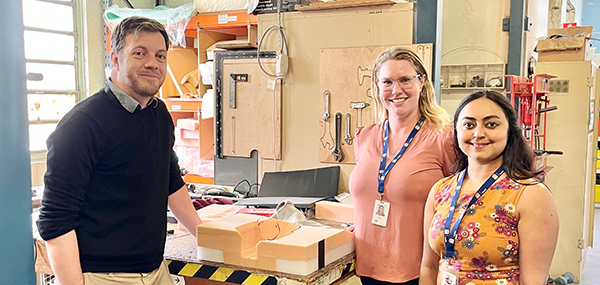Medical device reforms: what will it mean for clinicians?
15 December 2023
The Clinical Excellence Commission is working with NSW Health agencies to ensure medical device reforms introduced nationally are embedded into local safety and quality processes. Recently, we met with Senior Rehabilitation Engineer Dr Iain Brown from Macquarie Hospital to discuss the medical device reforms in his field of biomedical engineering, how he helps people live better lives, and what the reforms will mean for health professionals and patients.
You are part of the Assistive Technology & Seating (AT&S) team at Macquarie Hospital. Describe your role as a biomedical engineer.
We primarily provide specialist support in wheelchair seating for clients that use a wheelchair as their primary form of mobility. The service works with clients and health professionals to achieve the best configuration of equipment to achieve good pressure care, postural control, and lasting comfort while maximising the client's functional capacity.
In practice, this means that clients are set up with the assistive technologies that they need to live well, are not delayed in discharge due to inappropriate equipment and have a lower likelihood of needing to come back to hospital.
AT&S is an inherently multidisciplinary team, combining rehabilitation engineers, occupational therapists, physiotherapists, seating technicians and administrative support. Within this team, the engineer offers a unique perspective on clinical intervention, combining knowledge of the human body with knowledge of mechanical, electrical and mechatronic systems. Ultimately, this collaboration provides clients with creative, individual and specific solutions.
There are very few people in Australia that do the work you do.
Rehabilitation engineers have worked in public health in Australia since the 1970s, but it is not a widely recognised role, and the numbers have not grown significantly.
Currently, there are four rehabilitation engineering services in public health across Australia that focus on wheelchair seating. There are also a handful of rehabilitation engineers working to help people with their gait and motion. Outside public health, there are rehabilitation engineers working in broader areas including rehabilitation robotics, orthotics and prosthetics, brain-computer interfacing, research, as well as policy and program development.
I am hopeful that increasing awareness within public health might one day lead to more rehabilitation engineers being added to support internal innovations in clinical service delivery.

Dr Iain Brown with Danielle Murphy (centre) and Ambika Murthy (right) of the CEC’s Medical Device Governance Program.
How does this work improve people’s lives?
The most important thing we do as rehabilitation engineers is work with clients to achieve better health outcomes. This might include reconfiguring a wheelchair to better suit a client's needs. Or it might be assessing a client's needs, then matching them to appropriate equipment to prevent pressure wounds or manage and promote the healing of existing wounds. It might mean adjusting commercial equipment that doesn't quite suit the individual, or making something completely unique if there isn't anything on the market that will work.
It means working to keep people up, out of bed, engaged in the community, and living full and meaningful lives.
How will the medical device reforms affect your role?
The recent TGA reforms are designed to safeguard end users of medical devices from injury and harm. They seek to increase regulatory oversight of personalised medical devices, including devices that can now be fabricated easily using 3D printers.
For my role, this means reviewing our existing design and manufacturing process to ensure that they are adequately considered and documented. Within the broader context of the Northern Sydney Local Health District, it means identifying the various cases where internal manufacturing is already taking place, and working with local teams to similarly ensure appropriately robust procedures that comply with the TGA’s new requirements.
How will the reforms make devices safer for patients?
The reforms have greatly increased clinician awareness of medical device regulatory requirements that may have previously been poorly understood or adhered to.
The regulations are intended to ensure that medical devices are developed in a mindful way, by requiring manufacturers to conform with the Essential Principles of Design, a list of checks manufacturers must make to demonstrate that their products are fit for use. The application of these essential principles within public health will foster a more robust approach to assistive technology design and supply that ultimately protects clients from poorly designed, if well-meaning, products.
The reforms also require clients to be provided with adequate contact information to be able to follow up in the event of an issue. This lets consumers report and resolve issues early, and also, escalate an incident or concern should the need arise.
What challenges do you foresee?
Perhaps the biggest challenge will be ensuring that the procedures are followed in the context of extremely busy hospitals. The aims of the reforms are to ensure better protection for clients, rather than to increase the workload of health staff, but the workload will necessarily increase.
In public health, the challenges will include developing universal procedures, implementation and record-keeping. There are many services that have traditionally designed and fabricated client solutions that will now be required to adhere to revised regulatory requirements. The activities of these services are quite distinct, so there will be a tension between developing procedures specific to each service or developing a universally applicable procedure with enough nuance to meaningfully encompass the diversity.
The implementation process will, likewise, be a challenge, as it will mean altering existing, well-established practices, but any concerns will inform and potentially refine these procedures. I anticipate that the procedures can be sufficiently streamlined over time to improve patient safety and outcomes and prevent them adversely affecting clinical practice.
The CEC is the lead agency supporting safety and quality improvement across the NSW Health system. It is coordinating implementation of the Medical Device Governance Program (MDGP) in partnership with the Ministry of Health, Agency for Clinical Innovation, HealthShare NSW, eHealth NSW, Health Infrastructure, Local Health Districts and Speciality Health Networks. Subscribe here for MDGP updates.
